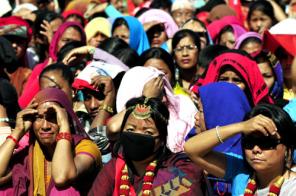Progress on women front slow: UNDP
KATHMANDU: Women in the Asia Pacific region have the lowest rates of representation in politics, employment and property ownership, a new report presented by the United Nations Development Programme (UNDP) has revealed.
The Asia Pacific Human Development report on gender, which was made public on the occasion of the 100th International Women’s Day today, revealed that women in the Asia Pacific region are socially, physically and economically backward and the progress remains slow particularly in South Asia.
According to the report, lack of women’s participation in productive sectors is a barrier for economic growth. The day was marked with the slogan ‘Equal Rights, Equal Opportunities: Progress for all’.
Binda Pandey, chairperson, Fundamental Rights and Directives Principle Committee of the Constituent Assembly said that Nepal has already made its way towards passing the Bill on domestic violence in the legislative parliament. It is a big leap towards the right direction, according to her.
“The 33 per cent representation of women in CA is a noteworthy progress,” Pandey said, adding that all women and men in the country have to change their orthodox attitude for successful implementation of Laws, Acts and policies.
The report revealed that the gap between women and men’s average daily income is alarmingly wider in Nepal.
Nepali women only earn around 60 per cent of what men earn doing similar jobs in both agricultural and non-agricultural sector, according to the report.
The report stated that giving women economic opportunities reduces gender-based violence- a problem common in the Asia Pacific region.
It also stated that the political voice of women has improved in Nepal with the recent secured one third quotas in the CA.
Robert Piper, resident representative, UNDP, said that increasing women’s participation in the labour market will boost the country’s income.
Highlights
• Asia is “missing” about 96 million women — the vast majority in China and India — who died of discriminatory health care and neglect or who were never born at all.
• More women die while giving birth in South Asia-500 for every 100,000 live births.
• East Asia has the world’s highest male-female sex ratio at birth, with 119 boys born for every 100 girls.
• Female infanticide and sex-selective abortion have caused a severe gender imbalance in Asia, and the problem has been worsening despite rapid economic growth in the region. This far exceeded the global world average of 107 boys for every 100 girls.
• A total of 67 per cent of East Asian women participate in the labour force above the global average of 53 per cent but South Asian women are far behind at only 36 per cent.
• Only about only one third of Asia-Pacific countries have gender quota in parliament.
• More than half the countries in South Asia and Pacific report assaults on women by their male partners.
• Nearly half of the countries in South Asia and more than 60 per cent of in Pacific do not have laws on domestic violence.






